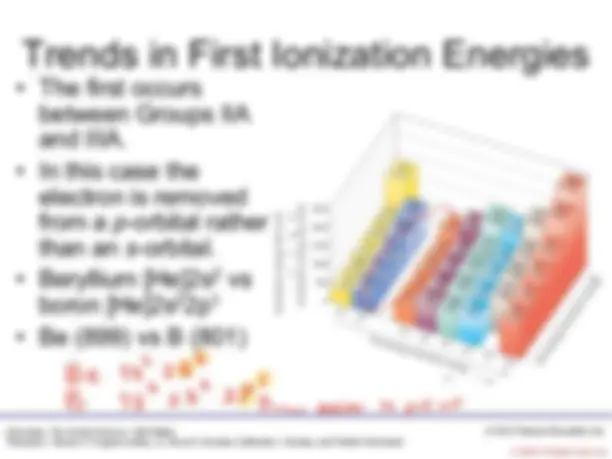Download Periodic Trends in Ionization Energy and Electron Affinity and more Slides Chemistry in PDF only on Docsity!
Periodic Properties of the
Elements
Development of the Periodic Table
Discovering the Elements
Dmitri Mendeleev and Lothar Meyer independently came to the same conclusion about how elements should be grouped. (^1871) O
In this chapter
- Effective Nuclear Charge
- Sizes of Atoms and Ions
- Ionization Energy
- Electron Affinity
- Metals, Nonmetals, and Metalloids
- Trends for Group 1A and Group 2A
- Trends for Selected Nonmetals P exam 3
Effective Nuclear Charge
- Many properties of atoms depend on electron configurations and on how strongly the outer electrons in the atoms are attracted to the nucleus
- The strength of the attraction between electrical charges depends on the magnitudes of the charges and on the distance between them (Coulomb’s Law)
- electrostatic potential energy. Eel ( interaction between charged particles) κ Q 1 Q 2 Eel =
d
- The attractive force between an electron and the nucleus depends on the magnitude of the nuclear charge and on the average distance between the nucleus and the electron É É O charges distance
Effective Nuclear Charge
- Electron-electron repulsion
cancel some of the attraction of
the electron to the nucleus so the
electron experience less
attraction.
- Electron experiences a net
attraction that is the result of the
nuclear attraction decreased by
the electron-electron repulsions.
- The partially screened nuclear
charge is called the effective
nuclear charge Z eff
Na
s
nucleus (^) I Il inner protons electrons sat Ft
Effective Nuclear Charge
- The effective nuclear charge, Z eff, is found this way: Z eff = Z − S
- where Z is the atomic number and S is a screening constant, usually close to the number of inner electrons. Na 7 1135 Nt I
atomicnumbers^
protons Test L^ S 11 10 It Zeff actual 2.5T
- Zeff increases from left to right across any period of the periodic table. o The number of core electrons stays the same across the period. o The number of protons increases
- Zeff changes far less going down a column than it does across the period
- Zeff increases slightly as we go down a column because of the more diffuse the core electron cloud is less able to screen the valence electrons from the nuclear charge.
- Li 1.3+
- Na 2.5+
- K 3.5+ Effective Nuclear Charge stinketeledron
is
me jp
g
core 9
Example Li Na K IYÉ Zeff
increase P
ie iKNas __ greatest for Zeff Ex (^) Be (^) N C Becc n
Sizes of Atoms and Ions
Consider a collection of argon atoms
in the gas phase.
- When they undergo collisions,
they ricochet apart because
electron clouds cannot penetrate
each other to a significant extent.
The apparent radius is
determined by the closest
distances separating the nuclei
during such collisions.
- This radius is the nonbonding
radius.
- Nonbonding atomic radii are also called van der Waals radii.
- These are used in space-filling models to represent the sizes of different elements.
Sizes of Atoms and Ions
- Now consider a simple diatomic molecule. - The distance between the
two nuclei is called the
bonding atomic radius.
- It is shorter than the nonbonding radius.
- If the two atoms that make up the molecule are the same, then half the bond distance is called the covalent radius of the atom. a __ bonding atomic radius I
Fig 7.
Bonding Atomic Radii for periods 1 through 5 bond length^ C Cl C C^ bondingradius (^) t bonding rad Cl
C
0.77 0. 1.76 (^) A O O O
Atomic size varies consistently through the periodic table.
- As we move down a group, the atoms become larger.
- As we move across a period, atoms become smaller. O j
I n 2 t
n 3 fisinfreases
Izesitsignly
nss
in a^ period T right Zeff T core é's^
same
size decreases
Using Figure 7.
- We can estimate bond lengths in molecules
- For example, the bonding atomic radii for C and Cl are 1.02 Å and 0.76 Å, respectively.
- The sum of the bonding atomic radii of Cl and C = 1.02 Å + 0.76 Å =1.78 Å
- In CCl 4 the measured length of C-Cl bond is 1.77 Å


































































































































































